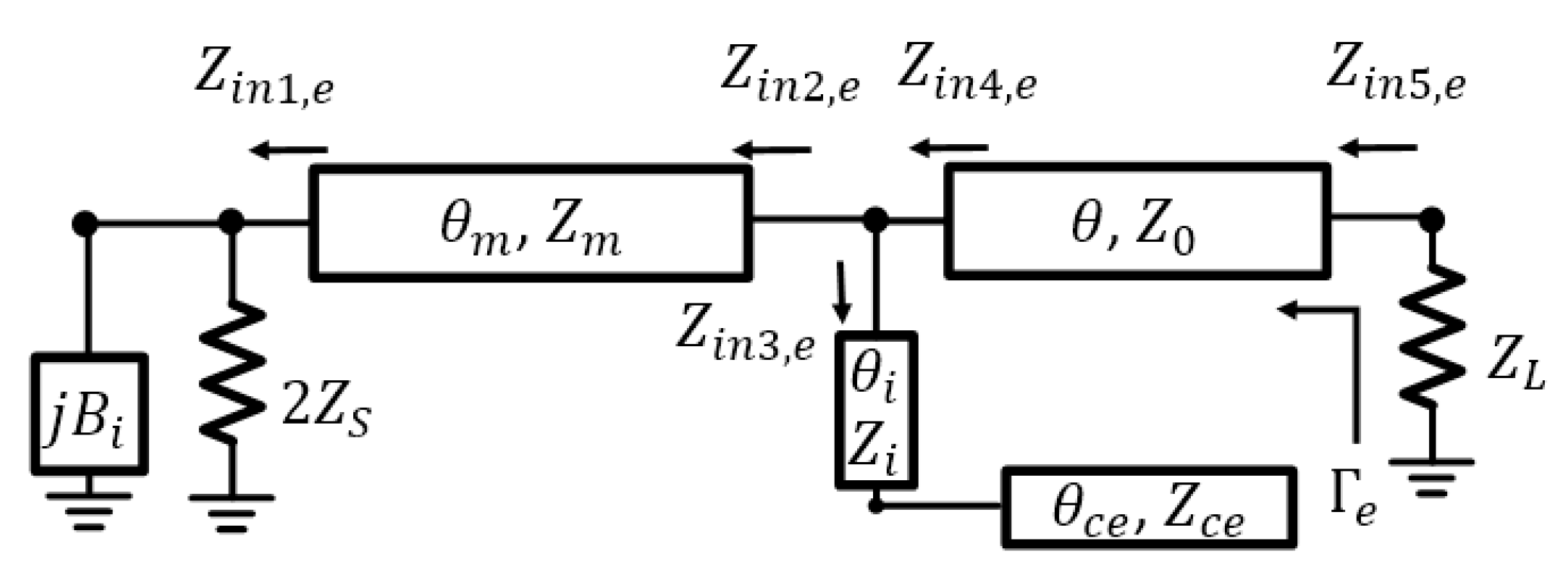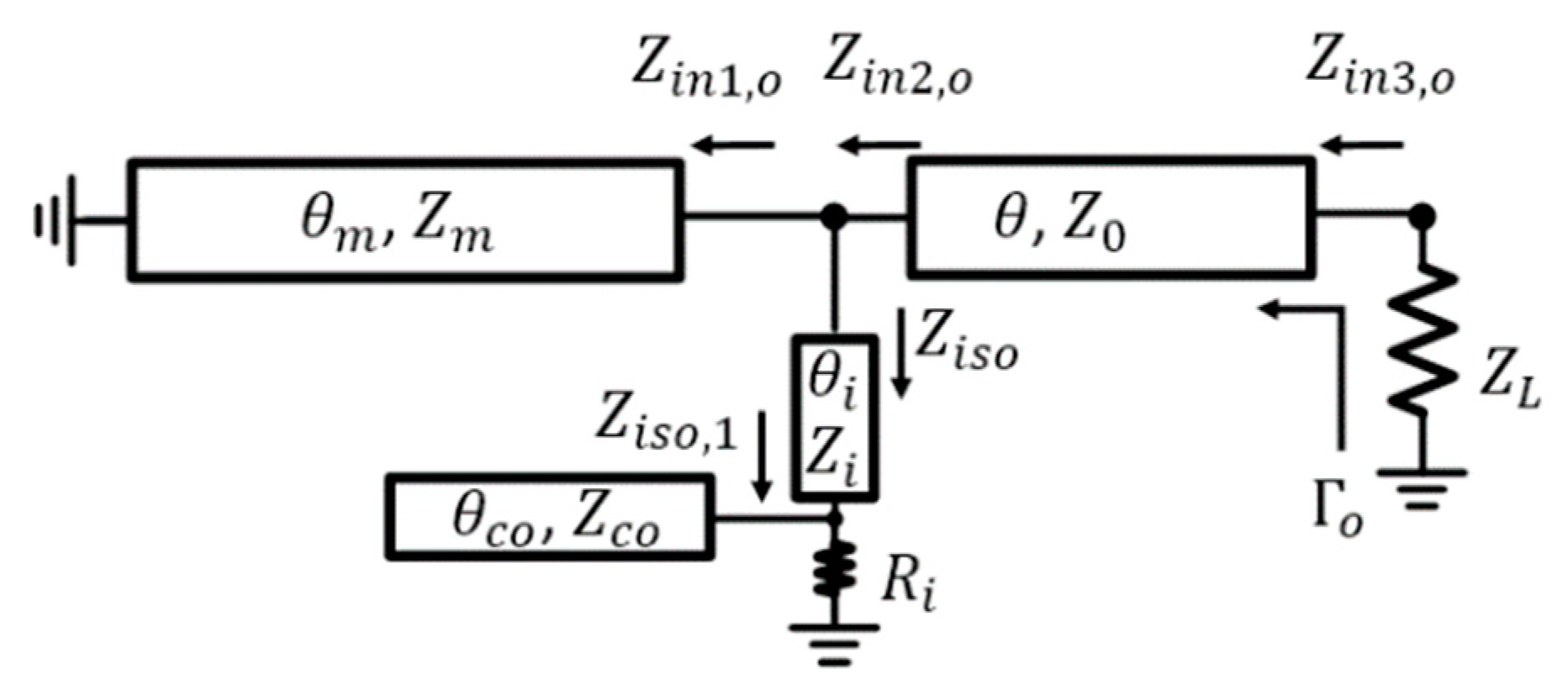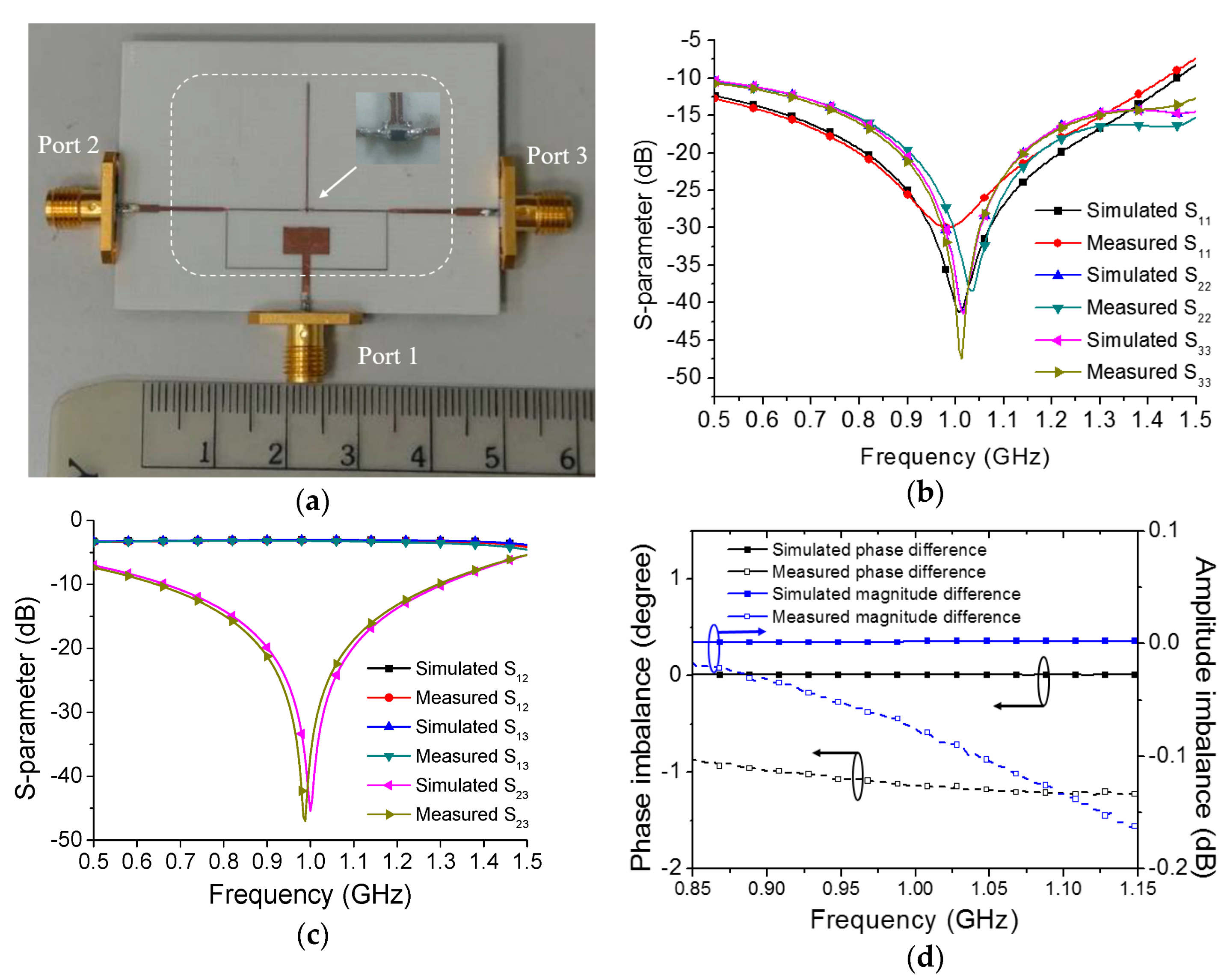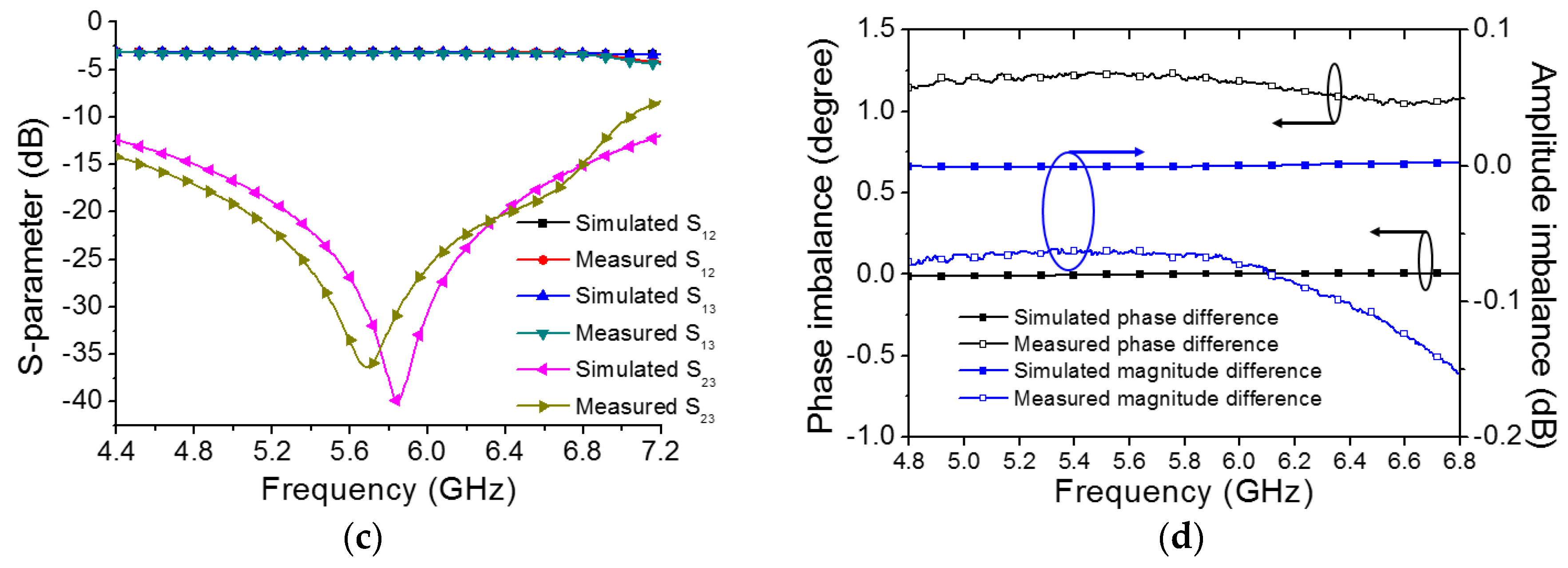Novel Low-Cost Power Divider for 5.8 GHz
Abstract
1. Introduction
2. Design and Analysis
2.1. Even-Mode Analysis
2.2. Odd-Mode Analysis
3. Experimental Verification
4. Conclusions
Author Contributions
Funding
Conflicts of Interest
References
- Wilkinson, E.J. An N-Way Hybrid Power Dividers. IEEE Trans. Microw. Theory Tech. 1960, 8, 116–118. [Google Scholar] [CrossRef]
- Scardelletti, M.C.; Ponchak, G.E.; Weller, T.M. Miniaturized Wilkinson power dividers utilizing capacitive loading. IEEE Microw. Wirel. Compon. Lett. 2002, 12, 6–8. [Google Scholar] [CrossRef]
- Trantanella, C.J. A novel power divider with enhanced physical and electrical port isolation. In Proceedings of the 2010 IEEE MTT-S International Microwave Symposium Digest, Anaheim, CA, USA, 23–28 May 2010; pp. 129–132. [Google Scholar]
- Choe, W.; Jeong, J. Compact Modified Wilkinson Power Divider With Physical Output Port Isolation. IEEE Microw. Wirel. Compon. Lett. 2014, 12, 845–847. [Google Scholar] [CrossRef]
- Kim, Y.; Yoon, Y.-C. A modified unequal power divider with a complex isolation component for enhanced isolation. Microw. Opt. Technol. Lett. 2015, 57, 322–324. [Google Scholar] [CrossRef]
- Choe, W.; Jeong, J. N-Way Unequal Wilkinson Power Divider With Physical Output Port Separation. IEEE Microw. Wirel. Compon. Lett. 2016, 26, 243–245. [Google Scholar] [CrossRef]
- Wang, X.; Sakagami, I.; Mase, A.; Ichimura, M. Wilkinson power divider with complex isolation component and its miniaturization. IEEE Trans. Microw. Theory Tech. 2014, 62, 422–430. [Google Scholar] [CrossRef]
- Du, Z.-X.; Zhang, X.Y.; Wang, K.-X.; Kao, H.-L.; Zhao, X.-L.; Li, X.H. Unequal Wilkinson power divider with reduced arm length for size miniaturization. IEEE Trans. Compon. Packag. Technol. 2016, 6, 282–289. [Google Scholar] [CrossRef]
- Antsos, D.; Crist, R.; Sukamto, L. A novel Wilkinson power divider with predictable performance at K and Ka-band. In Proceedings of the 1994 IEEE MTT-S International Microwave Symposium Digest, San Diego, CA, USA, 23–27 May 1994; pp. 907–910. [Google Scholar]
- Horst, S.; Bairavasubramanian, R.; Tentzeris, M.; Papapolymerou, J. Modified Wilkinson power dividers for millimeter-wave integrated circuits. IEEE Trans. Microw. Theory Tech. 2007, 55, 2439–2446. [Google Scholar] [CrossRef]
- Hammou, D.; Nedil, M.; Tatu, S.O. Design of improved ring Wilkinson power divider for millimetre wave applications. Electron. Lett. 2017, 53, 542–544. [Google Scholar] [CrossRef]
- Cheng, K.M.; Li, P. A Novel Power-Divider Design With Unequal Power-Dividing Ratio and Simple Layout. IEEE Trans. Microw. Theory Tech. 2009, 57, 1589–1594. [Google Scholar] [CrossRef]
- Hallberg, W.; Özen, M.; Kuylenstierna, D.; Buisman, K.; Fager, C. A Generalized 3-dB Wilkinson Power Divider/Combiner With Complex Terminations. IEEE Trans. Microw. Theory Tech. 2018, 66, 4497–4506. [Google Scholar] [CrossRef]








| Figure | wm | lm1 | lm2 | ltl | wtl | lp | wp | lti | wi | li | lte |
| 1 | 128 | 10,659 | 8141 | 2000 | 1100 | 4000 | 6500 | 225 | 199 | 8961 | 625 |
| 5.8 | 137 | 1658 | 1952 | 350 | 1100 | 968 | 3624 | 225 | 241 | 1608 | 625 |
| Freq. (GHz) | we | le | lcn1 | lcn2 | wcn | lRp | wRp | lRiso | wc | sc | lc |
| 1 | 584 | 10,609 | 52.5 | 232.5 | 75 | 150 | 300 | 450 | 105 | 75 | 17,925 |
| 5.8 | 521 | 1097 | 52.5 | 212.5 | 75 | 150 | 300 | 450 | 123 | 79 | 2795 |
| Ref. | (GHz) | Process | LPE 2 | Total Length (deg.) | ΔO/P 3 (deg.) | S11 (%BW) 4 | S22/S33 (%BW) 4 | S23 (%BW) 4 | Extra IL 5 (dB) |
|---|---|---|---|---|---|---|---|---|---|
| [7] | 1 | 1.965/5 | RC | 180 | 90 | 40 | 10 | 10 | <0.15 |
| [8] case 1 | 1.5 | 1.5/2.55 | RC | 198.5 | 180 | 31 | 12/2 | 6 | <0.15 |
| [10] | 60 | 0.05/3 | R | 227 | 47 | - | 10 | - | <0.3 |
| [12] case 1 | 1 | -/3.38 | R | 270 | 60 | 40 | >43 | 40 | <0.3 |
| [13] T.W.1 | 2 | 0.508/3.48 | R | 317 | 60 | - | 4 | >25 | 0.19 |
| [13] Conv. | 2 | 0.508/3.48 | R | 180 | 0 | 9 | 6 | >40 | 0.13 |
| This work 1 | 1 | 0.508/3.38 | R | 180.2 | 80 | 37 | 39/25 | 19 | <0.2 |
| This work 2 | 5.8 | 0.508/3.38 | R | 180.2 | 80 | 39 | 39/17 | 23 | <0.24 |
© 2020 by the authors. Licensee MDPI, Basel, Switzerland. This article is an open access article distributed under the terms and conditions of the Creative Commons Attribution (CC BY) license (http://creativecommons.org/licenses/by/4.0/).
Share and Cite
Chang, T.-J.; Pande, K.; Hsu, H.-T. Novel Low-Cost Power Divider for 5.8 GHz. Electronics 2020, 9, 699. https://doi.org/10.3390/electronics9040699
Chang T-J, Pande K, Hsu H-T. Novel Low-Cost Power Divider for 5.8 GHz. Electronics. 2020; 9(4):699. https://doi.org/10.3390/electronics9040699
Chicago/Turabian StyleChang, Tso-Jung, Krishna Pande, and Heng-Tung Hsu. 2020. "Novel Low-Cost Power Divider for 5.8 GHz" Electronics 9, no. 4: 699. https://doi.org/10.3390/electronics9040699
APA StyleChang, T.-J., Pande, K., & Hsu, H.-T. (2020). Novel Low-Cost Power Divider for 5.8 GHz. Electronics, 9(4), 699. https://doi.org/10.3390/electronics9040699







